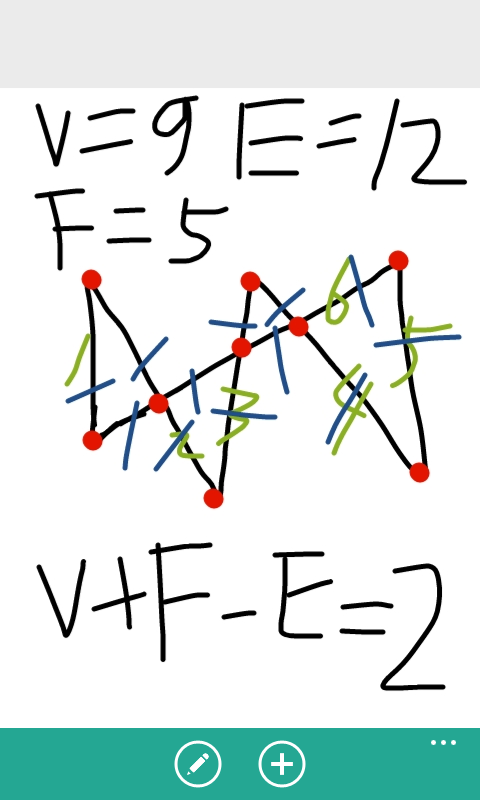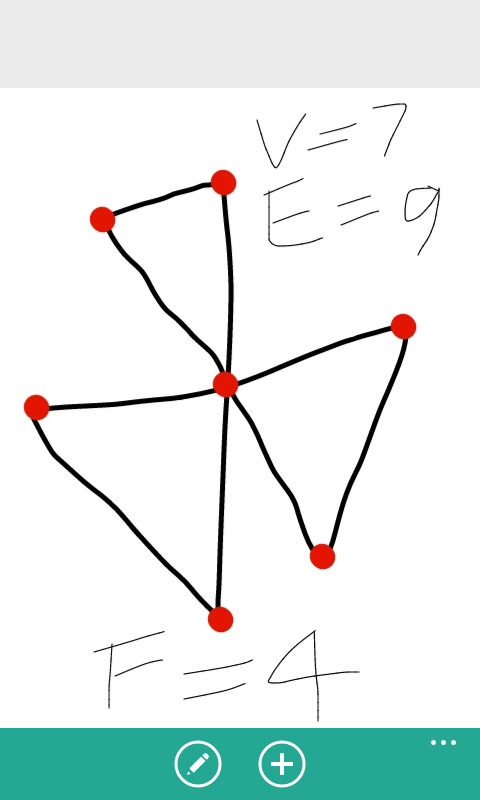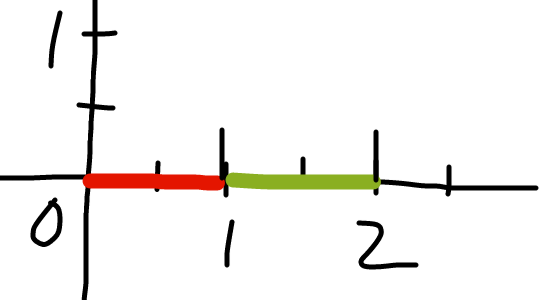题意:给出一图形,求该图形把平面分成了几部分
欧拉公式: http://blog.csdn.net/wangxiaojun911/article/details/4586550
对于二维平面上的情况。设图形上有V个点,E条边,把平面分成了F个独立的部分,那么满足V+F-E=2
如下图:


那么求F就转化成了如何求V和E
求V:枚举任意两线段的交点即可。注意可能出现三线共点的情况,要判重。
求E:某线段上的n个点会把这条线段分成n-1部分。用这个性质再YY一下就好了。
注意:
1.这里判重不能用map,因为交点的计算结果肯定是有精度误差的,再hash一下就没法判重了。
我用的方法是手艹了一个破vector,实际上有更简洁的方法.....
先排序,使重复的元素在数组里相邻。再用STL里的unique即可轻松实现去重
( Reference:http://blog.sina.com.cn/s/blog_a389f34a01013itn.html)
2.模板里的求两线段交点代码没有考虑这种情况:

如图,两线段分别为【(0,0)->(0,1)】和【(0,1)->(0,2)】
模板代码认为他们是不香蕉的= = 哼
所以这里要处理一下:
(大白书上lrj模板也存在这个问题)
//求两线交点 point crosspoint(line v) { if ((point_cmp(a,v.a))||(point_cmp(a,v.b))) return a; if ((point_cmp(b,v.a))||(point_cmp(b,v.b))) return b; //处理端点处相交的情况 double a1=v.b.sub(v.a).det(a.sub(v.a)); double a2=v.b.sub(v.a).det(b.sub(v.a)); return point((a.x*a2-b.x*a1)/(a2-a1),(a.y*a2-b.y*a1)/(a2-a1)); }
AC Code:

1 #include<vector> 2 #include<list> 3 #include<map> 4 #include<set> 5 #include<deque> 6 #include<queue> 7 #include<stack> 8 #include<bitset> 9 #include<algorithm> 10 #include<functional> 11 #include<numeric> 12 #include<utility> 13 #include<iostream> 14 #include<sstream> 15 #include<iomanip> 16 #include<cstdio> 17 #include<cmath> 18 #include<cstdlib> 19 #include<cctype> 20 #include<string> 21 #include<cstring> 22 #include<cstdio> 23 #include<cmath> 24 #include<cstdlib> 25 #include<ctime> 26 #include<climits> 27 #include<complex> 28 #define mp make_pair 29 #define pb push_back 30 using namespace std; 31 const double eps=1e-8;//精度 32 const double pi=acos(-1.0);//π 33 const double inf=1e20;//无穷大 34 const int maxp=1111;//最大点数 35 /* 36 判断d是否在精度内等于0 37 */ 38 int dblcmp(double d) 39 { 40 if (fabs(d)<eps)return 0; 41 return d>eps?1:-1; 42 } 43 44 45 bool dcmp(double x) 46 { 47 return (fabs(x)<eps); 48 } 49 50 /* 51 求x的平方 52 */ 53 inline double sqr(double x){return x*x;} 54 /* 55 点/向量 56 */ 57 struct point 58 { 59 double x,y; 60 point(){} 61 point(double _x,double _y):x(_x),y(_y){}; 62 //读入一个点 63 void input() 64 { 65 scanf("%lf%lf",&x,&y); 66 } 67 //输出一个点 68 void output() 69 { 70 printf("%.2f %.2f ",x,y); 71 } 72 //判断两点是否相等 73 bool operator==(point a)const 74 { 75 return dblcmp(a.x-x)==0&&dblcmp(a.y-y)==0; 76 } 77 //判断两点大小 78 bool operator<(point a)const 79 { 80 return dblcmp(a.x-x)==0?dblcmp(y-a.y)<0:x<a.x; 81 } 82 //点到源点的距离/向量的长度 83 double len() 84 { 85 return hypot(x,y); 86 } 87 //点到源点距离的平方 88 double len2() 89 { 90 return x*x+y*y; 91 } 92 //两点间的距离 93 double distance(point p) 94 { 95 return hypot(x-p.x,y-p.y); 96 } 97 //向量加 98 point add(point p) 99 { 100 return point(x+p.x,y+p.y); 101 } 102 //向量减 103 point sub(point p) 104 { 105 return point(x-p.x,y-p.y); 106 } 107 //向量乘 108 point mul(double b) 109 { 110 return point(x*b,y*b); 111 } 112 //向量除 113 point div(double b) 114 { 115 return point(x/b,y/b); 116 } 117 //点乘 118 double dot(point p) 119 { 120 return x*p.x+y*p.y; 121 } 122 //叉乘 123 double det(point p) 124 { 125 return x*p.y-y*p.x; 126 } 127 //XXXXXXX 128 double rad(point a,point b) 129 { 130 point p=*this; 131 return fabs(atan2(fabs(a.sub(p).det(b.sub(p))),a.sub(p).dot(b.sub(p)))); 132 } 133 //截取长度r 134 point trunc(double r) 135 { 136 double l=len(); 137 if (!dblcmp(l))return *this; 138 r/=l; 139 return point(x*r,y*r); 140 } 141 //左转90度 142 point rotleft() 143 { 144 return point(-y,x); 145 } 146 //右转90度 147 point rotright() 148 { 149 return point(y,-x); 150 } 151 //绕点p逆时针旋转angle角度 152 point rotate(point p,double angle) 153 { 154 point v=this->sub(p); 155 double c=cos(angle),s=sin(angle); 156 return point(p.x+v.x*c-v.y*s,p.y+v.x*s+v.y*c); 157 } 158 }; 159 160 bool point_cmp(point a,point b) 161 { 162 return ((dcmp(a.x-b.x))&&(dcmp(a.y-b.y))); 163 } 164 165 /* 166 线段/直线 167 */ 168 struct line 169 { 170 point a,b; 171 line(){} 172 line(point _a,point _b) 173 { 174 a=_a; 175 b=_b; 176 } 177 //判断线段相等 178 bool operator==(line v) 179 { 180 return (a==v.a)&&(b==v.b); 181 } 182 //点p做倾斜角为angle的射线 183 line(point p,double angle) 184 { 185 a=p; 186 if (dblcmp(angle-pi/2)==0) 187 { 188 b=a.add(point(0,1)); 189 } 190 else 191 { 192 b=a.add(point(1,tan(angle))); 193 } 194 } 195 //直线一般式ax+by+c=0 196 line(double _a,double _b,double _c) 197 { 198 if (dblcmp(_a)==0) 199 { 200 a=point(0,-_c/_b); 201 b=point(1,-_c/_b); 202 } 203 else if (dblcmp(_b)==0) 204 { 205 a=point(-_c/_a,0); 206 b=point(-_c/_a,1); 207 } 208 else 209 { 210 a=point(0,-_c/_b); 211 b=point(1,(-_c-_a)/_b); 212 } 213 } 214 //读入一个线段 215 void input() 216 { 217 a.input(); 218 b.input(); 219 } 220 //校准线段两点 221 void adjust() 222 { 223 if (b<a)swap(a,b); 224 } 225 //线段长度 226 double length() 227 { 228 return a.distance(b); 229 } 230 //直线倾斜角 0<=angle<180 231 double angle() 232 { 233 double k=atan2(b.y-a.y,b.x-a.x); 234 if (dblcmp(k)<0)k+=pi; 235 if (dblcmp(k-pi)==0)k-=pi; 236 return k; 237 } 238 //点和线段关系 239 //1 在逆时针 240 //2 在顺时针 241 //3 平行 242 int relation(point p) 243 { 244 int c=dblcmp(p.sub(a).det(b.sub(a))); 245 if (c<0)return 1; 246 if (c>0)return 2; 247 return 3; 248 } 249 //点是否在线段上 250 bool pointonseg(point p) 251 { 252 //if ((p==a) || (p==b)) return true; 253 return dblcmp(p.sub(a).det(b.sub(a)))==0&&dblcmp(p.sub(a).dot(p.sub(b)))<=0; 254 } 255 //两线是否平行 256 bool parallel(line v) 257 { 258 return dblcmp(b.sub(a).det(v.b.sub(v.a)))==0; 259 } 260 //线段和线段关系 261 //0 不相交 262 //1 非规范相交 263 //2 规范相交 264 int segcrossseg(line v) 265 { 266 int d1=dblcmp(b.sub(a).det(v.a.sub(a))); 267 int d2=dblcmp(b.sub(a).det(v.b.sub(a))); 268 int d3=dblcmp(v.b.sub(v.a).det(a.sub(v.a))); 269 int d4=dblcmp(v.b.sub(v.a).det(b.sub(v.a))); 270 if ((d1^d2)==-2&&(d3^d4)==-2)return 2; 271 return (d1==0&&dblcmp(v.a.sub(a).dot(v.a.sub(b)))<=0|| 272 d2==0&&dblcmp(v.b.sub(a).dot(v.b.sub(b)))<=0|| 273 d3==0&&dblcmp(a.sub(v.a).dot(a.sub(v.b)))<=0|| 274 d4==0&&dblcmp(b.sub(v.a).dot(b.sub(v.b)))<=0); 275 } 276 //线段和直线v关系 277 int linecrossseg(line v)//*this seg v line 278 { 279 int d1=dblcmp(b.sub(a).det(v.a.sub(a))); 280 int d2=dblcmp(b.sub(a).det(v.b.sub(a))); 281 if ((d1^d2)==-2)return 2; 282 return (d1==0||d2==0); 283 } 284 //直线和直线关系 285 //0 平行 286 //1 重合 287 //2 相交 288 int linecrossline(line v) 289 { 290 if ((*this).parallel(v)) 291 { 292 return v.relation(a)==3; 293 } 294 return 2; 295 } 296 //求两线交点 297 point crosspoint(line v) 298 { 299 if ((point_cmp(a,v.a))||(point_cmp(a,v.b))) return a; 300 if ((point_cmp(b,v.a))||(point_cmp(b,v.b))) return b; 301 double a1=v.b.sub(v.a).det(a.sub(v.a)); 302 double a2=v.b.sub(v.a).det(b.sub(v.a)); 303 return point((a.x*a2-b.x*a1)/(a2-a1),(a.y*a2-b.y*a1)/(a2-a1)); 304 } 305 306 //点p到直线的距离 307 double dispointtoline(point p) 308 { 309 return fabs(p.sub(a).det(b.sub(a)))/length(); 310 } 311 //点p到线段的距离 312 double dispointtoseg(point p) 313 { 314 if (dblcmp(p.sub(b).dot(a.sub(b)))<0||dblcmp(p.sub(a).dot(b.sub(a)))<0) 315 { 316 return min(p.distance(a),p.distance(b)); 317 } 318 return dispointtoline(p); 319 } 320 //XXXXXXXX 321 point lineprog(point p) 322 { 323 return a.add(b.sub(a).mul(b.sub(a).dot(p.sub(a))/b.sub(a).len2())); 324 } 325 //点p关于直线的对称点 326 point symmetrypoint(point p) 327 { 328 point q=lineprog(p); 329 return point(2*q.x-p.x,2*q.y-p.y); 330 } 331 }; 332 333 334 struct point P[1000]; 335 struct line L[1000]; 336 int n; 337 int CASE=0; 338 339 int main() 340 { 341 //freopen("in.txt","r",stdin); 342 343 while (cin>>n) 344 { 345 if (n==0) break; 346 { 347 CASE++; 348 n--; 349 for (int i=1;i<=n+1;i++) 350 { 351 scanf("%lf%lf",&P[i].x,&P[i].y); 352 if (i>=2) 353 L[i-1]=line(point(P[i-1].x,P[i-1].y),point(P[i].x,P[i].y)); 354 } 355 //L[1..n]:line P[1..n]:point P[1]==P[n+1] 356 357 vector<point> POINT; 358 POINT.clear(); 359 360 int pcount=0; //the number of points 361 for (int i=1;i<n;i++) 362 for (int j=i+1;j<=n;j++) 363 { 364 if (L[i].segcrossseg(L[j])!=0) 365 { 366 point tm=L[i].crosspoint(L[j]); 367 //printf("P: %.3f %.3f ",tm.x,tm.y); 368 bool Find=false; 369 for (vector<point>::iterator it=POINT.begin();it!=POINT.end();it++) 370 { 371 point tp=*it; 372 if ((dcmp(tp.x-tm.x))&&(dcmp(tp.y-tm.y))) 373 Find=true; 374 } 375 if (!Find) 376 { 377 pcount++; 378 POINT.push_back(tm); 379 } 380 } 381 } 382 383 for (vector<point>::iterator it=POINT.begin();it!=POINT.end();it++) 384 { 385 point tp=*it; 386 //printf("%.5f %.5f ",tp.x,tp.y); 387 } 388 389 int lcount=0; 390 for (int i=1;i<=n;i++) 391 { 392 line tm=L[i]; 393 int tmp=0; 394 for (vector<point>::iterator it=POINT.begin();it!=POINT.end();it++) 395 { 396 point tp=*it; 397 if (tm.pointonseg(tp)) 398 tmp++; 399 } 400 lcount=lcount+(tmp-1); 401 } 402 403 //cout<<pcount<<" "<<lcount<<endl; 404 //cout<<2+lcount-pcount<<endl; 405 //Case 1: There are 2 pieces. 406 int ans=2+lcount-pcount; 407 //if (ans<0) ans=2; 408 printf("Case %d: There are %d pieces. ",CASE,ans); 409 } 410 } 411 412 413 return 0; 414 }
PS:在poj discussion里面有人给出了这样一组数据:
4
0 0 0 1 0 2 0 0
答案为2
这组数据我过不去 ╮(╯▽╰)╭
不过这种情况本身就够坑的,所以也不影响AC啦 ╮(╯▽╰)╭
